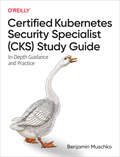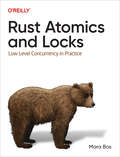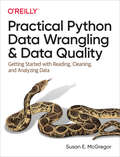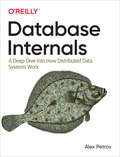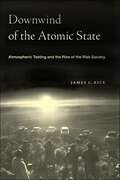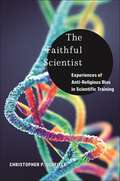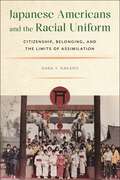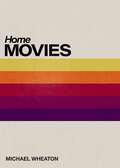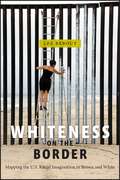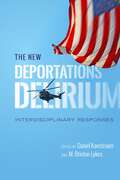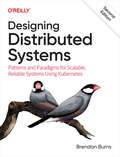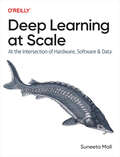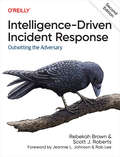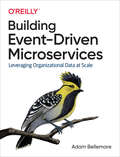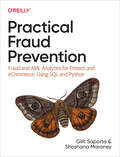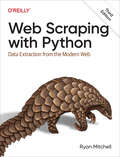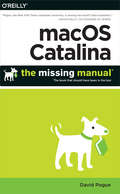- Table View
- List View
Certified Kubernetes Security Specialist (CKS) Study Guide: In-Depth Guidance and Practice
by Benjamin MuschkoVulnerabilities in software and IT infrastructure pose a major threat to organizations. In response, the Cloud Native Computing Foundation (CNCF) developed the Certified Kubernetes Security Specialist (CKS) certification to verify an administrator's proficiency to protect Kubernetes clusters and the cloud native software they contain. This practical book helps you fully prepare for the certification exam by walking you through all of the topics covered.Different from typical multiple-choice formats used by other certifications, this performance-based exam requires deep knowledge of the tasks it covers under intense time pressure. If you want to pass the CKS exam on the first go, author Benjamin Muschko shares his personal experience to help you learn the objectives, abilities, and tips and tricks you need to pass on the first attempt.Identify, mitigate, and/or minimize threats to cloud native applications and Kubernetes clustersLearn the ins and outs of Kubernetes's security features, and external tools for security detection and mitigation purposesDemonstrate competency to perform the responsibilities of a Kubernetes administrator or application developer with a security viewpointSolve real-world Kubernetes problems in a hands-on, command-line environmentEffectively navigate and solve questions during the CKS exam
Rust Atomics and Locks: Low-Level Concurrency in Practice
by Mara BosThe Rust programming language is extremely well suited for concurrency, and its ecosystem has many libraries that include lots of concurrent data structures, locks, and more. But implementing those structures correctly can be very difficult. Even in the most well-used libraries, memory ordering bugs are not uncommon.In this practical book, Mara Bos, leader of the Rust library team, helps Rust programmers of all levels gain a clear understanding of low-level concurrency. You'll learn everything about atomics and memory ordering and how they're combined with basic operating system APIs to build common primitives like mutexes and condition variables. Once you're done, you'll have a firm grasp of how Rust's memory model, the processor, and the role of the operating system all fit together.With this guide, you'll learn:How Rust's type system works exceptionally well for programming concurrency correctlyAll about mutexes, condition variables, atomics, and memory orderingWhat happens in practice with atomic operations on Intel and ARM processorsHow locks are implemented with support from the operating systemHow to write correct code that includes concurrency, atomics, and locksHow to build your own locking and synchronization primitives correctly
R Cookbook: Proven Recipes for Data Analysis, Statistics, and Graphics (Cookbook Ser.)
by Paul Teetor Jd LongPerform data analysis with R quickly and efficiently with more than 275 practical recipes in this expanded second edition. The R language provides everything you need to do statistical work, but its structure can be difficult to master. These task-oriented recipes make you productive with R immediately. Solutions range from basic tasks to input and output, general statistics, graphics, and linear regression.Each recipe addresses a specific problem and includes a discussion that explains the solution and provides insight into how it works. If you’re a beginner, R Cookbook will help get you started. If you’re an intermediate user, this book will jog your memory and expand your horizons. You’ll get the job done faster and learn more about R in the process.Create vectors, handle variables, and perform basic functionsSimplify data input and outputTackle data structures such as matrices, lists, factors, and data framesWork with probability, probability distributions, and random variablesCalculate statistics and confidence intervals and perform statistical testsCreate a variety of graphic displaysBuild statistical models with linear regressions and analysis of variance (ANOVA)Explore advanced statistical techniques, such as finding clusters in your data
Practical Python Data Wrangling and Data Quality: Getting Started with Reading, Cleaning, and Analyzing Data
by Susan E. McGregorThe world around us is full of data that holds unique insights and valuable stories, and this book will help you uncover them. Whether you already work with data or want to learn more about its possibilities, the examples and techniques in this practical book will help you more easily clean, evaluate, and analyze data so that you can generate meaningful insights and compelling visualizations.Complementing foundational concepts with expert advice, author Susan E. McGregor provides the resources you need to extract, evaluate, and analyze a wide variety of data sources and formats, along with the tools to communicate your findings effectively. This book delivers a methodical, jargon-free way for data practitioners at any level, from true novices to seasoned professionals, to harness the power of data.Use Python 3.8+ to read, write, and transform data from a variety of sourcesUnderstand and use programming basics in Python to wrangle data at scaleOrganize, document, and structure your code using best practicesCollect data from structured data files, web pages, and APIsPerform basic statistical analyses to make meaning from datasetsVisualize and present data in clear and compelling ways
Database Internals: A Deep Dive into How Distributed Data Systems Work
by Alex PetrovWhen it comes to choosing, using, and maintaining a database, understanding its internals is essential. But with so many distributed databases and tools available today, it’s often difficult to understand what each one offers and how they differ. With this practical guide, Alex Petrov guides developers through the concepts behind modern database and storage engine internals.Throughout the book, you’ll explore relevant material gleaned from numerous books, papers, blog posts, and the source code of several open source databases. These resources are listed at the end of parts one and two. You’ll discover that the most significant distinctions among many modern databases reside in subsystems that determine how storage is organized and how data is distributed.This book examines:Storage engines: Explore storage classification and taxonomy, and dive into B-Tree-based and immutable Log Structured storage engines, with differences and use-cases for eachStorage building blocks: Learn how database files are organized to build efficient storage, using auxiliary data structures such as Page Cache, Buffer Pool and Write-Ahead LogDistributed systems: Learn step-by-step how nodes and processes connect and build complex communication patternsDatabase clusters: Which consistency models are commonly used by modern databases and how distributed storage systems achieve consistency
Cloud Native Security Cookbook: Recipes for a Secure Cloud
by Josh ArmitageWith the rise of the cloud, every aspect of IT has been shaken to its core. The fundamentals for building systems are changing, and although many of the principles that underpin security still ring true, their implementation has become unrecognizable. This practical book provides recipes for AWS, Azure, and GCP to help you enhance the security of your own cloud native systems.Based on his hard-earned experience working with some of the world's biggest enterprises and rapidly iterating startups, consultant Josh Armitage covers the trade-offs that security professionals, developers, and infrastructure gurus need to make when working with different cloud providers. Each recipe discusses these inherent compromises, as well as where clouds have similarities and where they're fundamentally different.Learn how the cloud provides security superior to what was achievable in an on-premises worldUnderstand the principles and mental models that enable you to make optimal trade-offs as part of your solutionLearn how to implement existing solutions that are robust and secure, and devise design solutions to new and interesting problemsDeal with security challenges and solutions both horizontally and vertically within your business
Downwind of the Atomic State: Atmospheric Testing and the Rise of the Risk Society
by James C. Rice2024 Outstanding Academic Title, given by Choice ReviewsHow the scientific community overlooked, ignored, and denied the catastrophic fallout of decades of nuclear testing in the American WestIn December of 1950, President Harry Truman gave authorization for the Atomic Energy Commission to conduct weapons tests and experiments on a section of a Nevada gunnery range. Over the next eleven years, more than a hundred detonations were conducted at the Nevada Test Site, and radioactive debris dispersed across the communities just downwind and through much of the country. In this important work, James C. Rice tells the hidden story of nuclear weapons testing and the negligence of the US government in protecting public health.Downwind of the Atomic State focuses on the key decisions and events shaping the Commission’s mismanagement of radiological contamination in the region, specifically on how the risks of fallout were defined and redefined, or, importantly, not defined at all, owing to organizational mistakes and the impetus to keep atomic testing going at all costs. Rice shows that although Atomic Energy Commission officials understood open-air detonations injected radioactive debris into the atmosphere, they did not understand, or seem to care, that the radioactivity would irrevocably contaminate these communities.The history of the atomic Southwest should be a wake-up call to everyone living in a world replete with large, complex organizations managing risky technological systems. The legacy of open-air detonations in Nevada pushes us to ask about the kinds of risks we are unwittingly living under today. What risks are we being exposed to by large organizations under the guise of security and science?
The Faithful Scientist: Experiences of Anti-Religious Bias in Scientific Training
by Christopher P. ScheitleReveals biases within scientific PhD training programs against emerging scientists who embrace a religious faith and the ramifications for scienceScience is often viewed as antithetical to religion, and it is true that scientists, particularly those who work at universities, are generally much less religious than the average American adult. So what is it like to be a religious individual pursuing an advanced education and career in science? Featuring engaging interviews and survey data from over 1,300 PhD students in the natural and social sciences, The Faithful Scientist shows that the core challenge is not contending with contradictions between faith-based beliefs and scientific knowledge. Instead, it is the bias budding scientific practitioners face from their colleagues if they are religious.These dynamics are important for science as a field, and ultimately for those who engage with or benefit from the results of scientific research. There are real benefits to fostering diversity in science, which may lead to more useful discoveries for populations who have generally not been the focus of research. And women, Black, and Latina/o people tend in general to be more religious than their white male peers, meaning that diversifying the gender, ethnic, and racial composition of the scientific workforce likely requires diversifying the religious composition too. This book offers vital empirical data that provide insight into what it means to support and foster religious diversity in science.
Japanese Americans and the Racial Uniform: Citizenship, Belonging, and the Limits of Assimilation (Asian American Sociology)
by Dana Y. NakanoHow race continues to shape the citizenship and everyday lives of later-generation JapaneseAmericansJapanese Americans are seen as the “model minority,” a group that has fully assimilated and excelled within the US. Yet third- and fourth-generation Japanese Americans continue to report feeling marginalized within the predominantly white communities they call home. Japanese Americans and the Racial Uniform explores this apparent contradiction, challenging the way society understands the role of race in social and cultural integration.To explore race and the everyday practices of citizenship, Dana Y. Nakano begins at an unlikely site, Japanese Village and Deer Park, a now defunct Japan-themed amusement park in suburban Southern California. Drawing from extensive interviews with the park’s Japanese American employees as well as photographic imagery, Nakano shows how the employees' race acted as part of their work uniform and magnified their sense of alienation from their white peers and the park’s white visitors. While the racial perception of Japanese Americans as forever foreigners made them ideal employees for Deer Park, the same stigma continues to marginalizes Japanese Americans beyond the place and time of the amusement park. Into the present day, third and fourth generation Japanese Americans share feelings of racialized non-belonging and yearning for community. Japanese Americans and the Racial Uniform pushes us to rethink the persistent recognition of racial markers—the racial body as a visible, ever-present uniform—and how it continues to impact claims on an American identity and the lived experience of citizenship.
States of Return: Rethinking Migration and Mobility
by Deborah A. Boehm Mikaela H. Rogozen-SoltarExplores global migration through the concept of “return”The current global moment is characterized by both forced and desired returns, whether it’s the United States’ mass deportations to Mexico, ships carrying North African migrants turned back en route to Spain and Italy, urban Chinese migrants going back to their rural home communities, or domestic workers returning to their families in Bolivia and Ghana. Yet, the majority of migration research still centers unidirectional movement, which assumes settlement in a host country.States of Return addresses the many political, economic, and cultural transitions that have accelerated and transformed return during the first decades of the twenty-first century, including new migratory routes, new forms of violence, changing economic conditions, new regulatory regimes of incarceration and deportation, and generational transitions.This volume features contributions from leading scholars and offers a new theorization of the idea of return. It centers migrants’ own understandings of what return movement is and is not, and how it is experienced in terms of impacts on family relationships as well as state interventions that guide return migrations and create new configurations of citizenship and belonging, especially as migrant workers tend to return to states that lack strong infrastructures to support them or welcome them back.At its core, States of Return highlights the ways in which different migrants’ returns reflect conditions of power, privilege, injustice, and violence. The result is a broad and deep account of returns—imagined, achieved, thwarted, or impossible—that captures movement across borders in the world today.
Acts of Transgression: Contemporary Live Art in South Africa
by Catherine BoulleFifteen writers explore the experimental, interdisciplinary and radically transgressive field of contemporary live art in South Africa, focusing on a wide range of perspectives, personalities and theoretical concerns Contemporary South African society is chronologically ‘post’ apartheid, but it continues to grapple with material redress, land redistribution and systemic racism. Acts of Transgression represents the complexity of this moment in the rich potential of a performative art form that transcends disciplinary boundaries and aesthetic conventions. The contributors, who are all significantly involved in the discipline of performance art, probe its intersection with crisis and socio-political turbulence, shifting notions of identity and belonging, embodied trauma and loss. Narratives of the past and visions for the future are interrogated through memory and the archive, thus destabilising entrenched colonial systems.Collectively analysing the work of more than 25 contemporary South African artists, including Athi-Patra Ruga, Mohau Modisakeng, Steven Cohen, Dean Hutton, Mikhael Subotzsky, Tracey Rose and Donna Kukama, among others, the analysis is accompanied by a visual record of more than 50 photographs. For those working in the fields of theatre, performance studies and art, this is a must-have collection of critical essays on a burgeoning and exciting field of contemporary South African research.
Home Movies
by Michael WheatonHome Movies is an essay about the day-to-day realities and unrealities of its author’s hypermediated consumer life as a teacher and parent in Orlando, Florida. In each of the essay’s seven sections, Wheaton explores his relationships to new media and old tech, and the people around him, with thoughtful ambivalence and humor. Altogether, the various threads of Home Movies—image, tangibility, fame, nostalgia, simulation, marijuana, and cinema history—pull together into a moving attempt to accept the tensions between watching/being watched and life/art.
Popular Culture and the Civic Imagination: Case Studies of Creative Social Change
by Henry Jenkins William Proctor Elisabeth Soep Jonathan Gray Stephen Duncombe Sarah Banet-Weiser Ethan Zuckerman Rebecca Wanzo Sam Ford Sangita Shresthova Candis Callison Michael Saler Manisha Pathak-Shelat Gabriel Peters-Lazaro Christopher Harris Joan Miller Clifford Lee Thomas J Billard Lauren Levitt Taylor Cole Miller Raffi Sarkissian Sarah Van Wart Tapan Parikh Emilia Yang Andrea Alarcón Diana Lee Brooklyne Gipson Jocelyn Kelvin Donna Do-own Kim Yomna Elsayed Sulafa Zidani Rachel E. Moran Paromita Sengupta Clint Schnekloth Ioana Mischie Rogelio Alejandro LopezWinner, 2021 Ray and Pat Browne Edited Collection Award, given by the Popular Culture AssociationHow popular culture is engaged by activists to effect emancipatory political change One cannot change the world unless one can imagine what a better world might look like. Civic imagination is the capacity to conceptualize alternatives to current cultural, social, political, or economic conditions; it also requires the ability to see oneself as a civic agent capable of making change, as a participant in a larger democratic culture. Popular Culture and the Civic Imagination represents a call for greater clarity about what we’re fighting for—not just what we’re fighting against. Across more than thirty examples from social movements around the world, this casebook proposes “civic imagination” as a framework that can help us identify, support, and practice new kinds of communal participation. As the contributors demonstrate, young people, in particular, are turning to popular culture—from Beyoncé to Bollywood, from Smokey Bear to Hamilton, from comic books to VR—for the vernacular through which they can express their discontent with current conditions.A young activist uses YouTube to speak back against J. K. Rowling in the voice of Cho Chang in order to challenge the superficial representation of Asian Americans in children’s literature. Murals in Los Angeles are employed to construct a mythic imagination of Chicano identity. Twitter users have turned to #BlackGirlMagic to highlight the black radical imagination and construct new visions of female empowerment. In each instance, activists demonstrate what happens when the creative energies of fans are infused with deep political commitment, mobilizing new visions of what a better democracy might look like.
Public Intellectuals in South Africa: Critical voices from the past
by Chris BroodrykThis edited collection gives voice to neglected public intellectuals in the arts, humanities, and journalism in South Africa who gave voice and presence to those who have been marginalized and silenced in South African historyEdward Said described a public intellectual as someone who uses accessible language to address a designated public on matters of social and political significance. The essays in Public Intellectuals in South Africa apply this interpretive prism and activist principle to a South African context and tell the stories of well-known figures as well as some that have been mostly forgotten. They include Magema Fuze, John Dube, Aggrey Klaaste, Mewa Ramgobin and Koos Roets, alongside marginalized figures such as Elijah Makiwane, Mandisi Sindo, William Pretorius and Dr Thomas Duncan Greenlees.The essays capture the thoughts and opinions of these historical figures, who the contributors argue are public intellectuals who spoke out against the corruption of power, promoted a progressive politics that challenged the colonial project and its legacies, and encouraged a sustained dissent of the political status quo. Offering fascinating accounts of the life and work of these writers, critics and activists across a range of historical contexts and disciplines, from journalism and arts criticism to history and politics, it enriches the historical record of South African public intellectual life.This volume makes a significant contribution to ongoing debates about the value of research in the arts and humanities, and what constitutes public intellectualism in South Africa.
Whiteness on the Border: Mapping the US Racial Imagination in Brown and White (Nation of Nations #19)
by Lee BeboutThe many lenses of racism through which the white imagination sees Mexicans and Chicanos Historically, ideas of whiteness and Americanness have been built on the backs of racialized communities. The legacy of anti-Mexican stereotypes stretches back to the early nineteenth century when Anglo-American settlers first came into regular contact with Mexico and Mexicans. The images of the Mexican Other as lawless, exotic, or non-industrious continue to circulate today within US popular and political culture. Through keen analysis of music, film, literature, and US politics, Whiteness on the Border demonstrates how contemporary representations of Mexicans and Chicano/as are pushed further to foster the idea of whiteness as Americanness. Illustrating how the ideologies, stories, and images of racial hierarchy align with and support those of fervent US nationalism, Lee Bebout maps the relationship between whiteness and American exceptionalism. He examines how renderings of the Mexican Other have expressed white fear, and formed a besieged solidarity in anti-immigrant rhetoric and policies. Moreover, Whiteness on the Border elucidates how seemingly positive representations of Mexico and Chicano/as are actually used to reinforce investments in white American goodness and obscure systems of racial inequality. Whiteness on the Border pushes readers to consider how the racial logic of the past continues to thrive in the present.
The New Deportations Delirium: Interdisciplinary Responses (Citizenship and Migration in the Americas #7)
by Daniel Kanstroom M. Brinton LykesSince 1996, when the deportation laws were hardened, millions of migrants to the U.S., including many long-term legal permanent residents with “green cards,” have experienced summary arrest, incarceration without bail, transfer to remote detention facilities, and deportation without counsel—a life-time banishment from what is, in many cases, the only country they have ever known. U.S.-based families and communities face the loss of a worker, neighbor, spouse, parent, or child. Many of the deported are “sentenced home” to a country which they only knew as an infant, whose language they do not speak, or where a family lives in extreme poverty or indebtedness for not yet being able to pay the costs of their previous migration. But what does this actually look like and what are the systems and processes and who are the people who are enforcing deportation policies and practices? The New Deportations Delirium responds to these questions.Taken as a whole, the volume raises consciousness about the complexities of the issues and argues for the interdisciplinary dialogue and response. Over the course of the book, deportation policy is debated by lawyers, judges, social workers, researchers, and clinical and community psychologists as well as educators, researchers, and community activists. The New Deportations Delirium presents a fresh conversation and urges a holistic response to the complex realities facing not only migrants but also the wider U.S. society in which they have sought a better life.
Introducing Python: Modern Computing in Simple Packages
by Bill LubanovicEasy to understand and fun to read, this updated edition of Introducing Python is ideal for beginning programmers as well as those new to the language. Author Bill Lubanovic takes you from the basics to more involved and varied topics, mixing tutorials with cookbook-style code recipes to explain concepts in Python 3. End-of-chapter exercises help you practice what you’ve learned.You’ll gain a strong foundation in the language, including best practices for testing, debugging, code reuse, and other development tips. This book also shows you how to use Python for applications in business, science, and the arts, using various Python tools and open source packages.
Designing Distributed Systems: Patterns and Paradigms for Scalable, Reliable Systems Using Kubernetes
by Brendan BurnsEvery distributed system strives for reliability, performance, and quality, but building such a system is hard. Establishing a set of design patterns enables software developers and system architects to use a common language to describe their systems and learn from the patterns and practices developed by others.The popularity of containers and Kubernetes paves the way for core distributed system patterns and reusable containerized components. This practical guide presents a collection of repeatable, generic patterns to help guide the systems you build using common patterns and practices drawn from some of the highest performing distributed systems in use today. These common patterns make the systems you build far more approachable and efficient, even if you've never built a distributed system before.Author Brendan Burns demonstrates how you can adapt existing software design patterns for designing and building reliable distributed applications. Systems engineers and application developers will learn how these long-established patterns provide a common language and framework for dramatically increasing the quality of your system.This fully updated second edition includes new chapters on AI inference, AI training, and building robust systems for the real world.Understand how patterns and reusable components enable the rapid development of reliable distributed systemsUse the sidecar, adapter, and ambassador patterns to split your application into a group of containers on a single machineExplore loosely coupled multinode distributed patterns for replication, scaling, and communication between componentsLearn distributed system patterns for large-scale batch data processing covering work queues, event-based processing, and coordinated workflows
Deep Learning at Scale: At the Intersection of Hardware, Software, and Data
by Suneeta MallBringing a deep-learning project into production at scale is quite challenging. To successfully scale your project, a foundational understanding of full stack deep learning, including the knowledge that lies at the intersection of hardware, software, data, and algorithms, is required.This book illustrates complex concepts of full stack deep learning and reinforces them through hands-on exercises to arm you with tools and techniques to scale your project. A scaling effort is only beneficial when it's effective and efficient. To that end, this guide explains the intricate concepts and techniques that will help you scale effectively and efficiently.You'll gain a thorough understanding of:How data flows through the deep-learning network and the role the computation graphs play in building your modelHow accelerated computing speeds up your training and how best you can utilize the resources at your disposalHow to train your model using distributed training paradigms, i.e., data, model, and pipeline parallelismHow to leverage PyTorch ecosystems in conjunction with NVIDIA libraries and Triton to scale your model trainingDebugging, monitoring, and investigating the undesirable bottlenecks that slow down your model trainingHow to expedite the training lifecycle and streamline your feedback loop to iterate model developmentA set of data tricks and techniques and how to apply them to scale your training modelHow to select the right tools and techniques for your deep-learning projectOptions for managing the compute infrastructure when running at scale
Intelligence-Driven Incident Response: Outwitting the Adversary
by Rebekah Brown Scott J. RobertsUsing a well-conceived incident response plan in the aftermath of an online security breach enables your team to identify attackers and learn how they operate. But only when you approach incident response with a cyber threat intelligence mindset will you truly understand the value of that information. In this updated second edition, you'll learn the fundamentals of intelligence analysis as well as the best ways to incorporate these techniques into your incident response process.Each method reinforces the other: threat intelligence supports and augments incident response, while incident response generates useful threat intelligence. This practical guide helps incident managers, malware analysts, reverse engineers, digital forensics specialists, and intelligence analysts understand, implement, and benefit from this relationship.In three parts, this in-depth book includes:The fundamentals: Get an introduction to cyberthreat intelligence, the intelligence process, the incident response process, and how they all work togetherPractical application: Walk through the intelligence-driven incident response (IDIR) process using the F3EAD process: Find, Fix, Finish, Exploit, Analyze, and DisseminateThe way forward: Explore big-picture aspects of IDIR that go beyond individual incident response investigations, including intelligence team building
iOS Swift Game Development Cookbook: Simple Solutions for Game Development Problems
by Paris Buttfield-Addison Jonathon ManningReady to make amazing games for the iPhone and iPad? With Apple’s Swift programming language, it’s never been easier. This updated cookbook provides detailed recipes for managing a wide range of common iOS game-development issues, ranging from 2D and 3D math, SpriteKit, and OpenGL to augmented reality with ARKit.You get simple, direct solutions to common problems found in iOS game programming. Need to figure out how to give objects physical motion, or want a refresher on gaming-related math problems? This book provides sample projects and straightforward answers. All you need to get started is some familiarity with iOS development in Swift.
Building Event-Driven Microservices: Leveraging Organizational Data At Scale
by Adam BellemareOrganizations today often struggle to balance business requirements with ever-increasing volumes of data. Additionally, the demand for leveraging large-scale, real-time data is growing rapidly among the most competitive digital industries. Conventional system architectures may not be up to the task. With this practical guide, you’ll learn how to leverage large-scale data usage across the business units in your organization using the principles of event-driven microservices.Author Adam Bellemare takes you through the process of building an event-driven microservice-powered organization. You’ll reconsider how data is produced, accessed, and propagated across your organization. Learn powerful yet simple patterns for unlocking the value of this data. Incorporate event-driven design and architectural principles into your own systems. And completely rethink how your organization delivers value by unlocking near-real-time access to data at scale.You’ll learn:How to leverage event-driven architectures to deliver exceptional business valueThe role of microservices in supporting event-driven designsArchitectural patterns to ensure success both within and between teams in your organizationApplication patterns for developing powerful event-driven microservicesComponents and tooling required to get your microservice ecosystem off the ground
Practical Fraud Prevention: Fraud and AML Analytics for Fintech and eCommerce, Using SQL and Python
by Gilit Saporta Shoshana MaraneyOver the past two decades, the booming ecommerce and fintech industries have become a breeding ground for fraud. Organizations that conduct business online are constantly engaged in a cat-and-mouse game with these invaders. In this practical book, Gilit Saporta and Shoshana Maraney draw on their fraud-fighting experience to provide best practices, methodologies, and tools to help you detect and prevent fraud and other malicious activities.Data scientists, data analysts, and fraud analysts will learn how to identify and quickly respond to attacks. You'll get a comprehensive view of typical incursions as well as recommended detection methods. Online fraud is constantly evolving. This book helps experienced researchers safely guide and protect their organizations in this ever-changing fraud landscape.With this book, you will:Examine current fraud attacks and learn how to mitigate themFind the right balance between preventing fraud and providing a smooth customer experienceShare insights across multiple business areas, including ecommerce, banking, cryptocurrency, anti-money laundering, and ad techEvaluate potential risks for a new vertical, market, or productTrain and mentor teams by boosting collaboration and kickstarting brainstorming sessionsGet a framework of fraud methods, fraud-fighting analytics, and data science methodologies
Web Scraping with Python: Collecting More Data From The Modern Web
by Ryan MitchellIf programming is magic, then web scraping is surely a form of wizardry. By writing a simple automated program, you can query web servers, request data, and parse it to extract the information you need. This thoroughly updated third edition not only introduces you to web scraping but also serves as a comprehensive guide to scraping almost every type of data from the modern web.Part I focuses on web scraping mechanics: using Python to request information from a web server, performing basic handling of the server's response, and interacting with sites in an automated fashion. Part II explores a variety of more specific tools and applications to fit any web scraping scenario you're likely to encounter.Parse complicated HTML pagesDevelop crawlers with the Scrapy frameworkLearn methods to store the data you scrapeRead and extract data from documentsClean and normalize badly formatted dataRead and write natural languagesCrawl through forms and loginsScrape JavaScript and crawl through APIsUse and write image-to-text softwareAvoid scraping traps and bot blockersUse scrapers to test your website
macOS Catalina: The Book That Should Have Been in the Box
by David PogueApple gives macOS new features and improvements right on your desktop and under the hood with Catalina—aka OS X 10.15. With this updated guide, you’ll learn how to use your iPad as a second screen, work with iPad apps on your Mac, and use Screen Time on your Mac. This new edition of the #1 bestselling Mac book shows you how to use the revamped apps for Music, Podcasts, and TV.Loaded with illustrations, step-by-step instructions, tips, and tricks, this book from David Pogue—Missing Manual series creator, New York Times columnist, and Emmy-winning tech correspondent for CNBC, CBS, and NPR—covers everything Catalina has to offer with lots of humor and technical insight.
